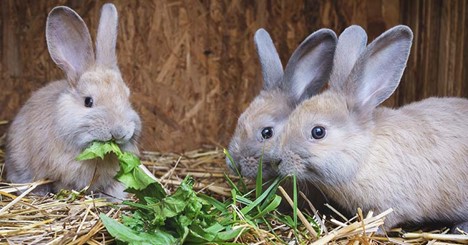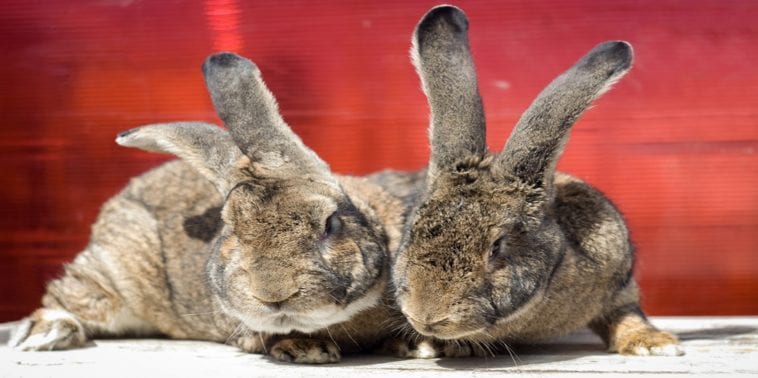Rabbits are now common livestock due to their fast reproduction and healthy meat. Most breeders today often cater to rabbits as they produce much faster and larger than any other livestock. Rabbits mature fast and are sexually available in a short period.
Mature female rabbits or does have the capability to produce offspring in large quantities over a short span. Once they give birth, they are often ready to be bred again. With the help of a proper breeding program, female rabbits can produce as much as 50 or more offspring in a given year if they are under the right condition. However, this type of intensive breeding should only be followed if you are into the commercial production of rabbit meat.
Breeding Schedule

If you are into the mass production of rabbit meat, breeding schedules are important to keep the pace and have the proper stock. Breeding schedules are normally tracked in a 7-day interval. This will make recordkeeping a lot easier.
Most experienced breeders will have a 14 to 21-day interval for the breeding schedule of their does. Beginners are highly likely to have a 35-day breeding schedule and slowly shorten the interval once the experience is gathered. This way, you can avoid having to put down your does due to exhaustion or burn out.
Factors That Affect Rabbit Breeding

In breeding does and bucks, there are a lot of factors that need to be considered first. It is important to adhere to these factors to limit the number of errors when breeding rabbits and produce high-quality litter from healthy does and bucks. Here are some of them:
The Importance of Breeding Schedule
As mentioned above, the breeding schedule is highly important to seasoned breeders and beginners. Do note that rabbits are living creatures, and they also need rest. Breeding them constantly without having time for rest will burn these animals out, and you are left with either unhealthy or exhausted rabbits.
Keep a record on the days that you breed your rabbits to track their schedule. This will help you space the breeding time for each rabbit.
Health Condition
Before breeding does and bucks, it is essential that you check the health condition of your rabbits. Does who have just produced a large litter will need a bit more time before they are ready to reproduce. Breeding it again will affect her performance and you may end up having a weak litter or small quantity.
Additionally, breeding could immediately result in a high death rate or poor fertility. A healthy doe can produce around 7 or 8 fryers, and it will depend on the breed.
Breed
Speaking of breeds, certain rabbit breeds reach maturity faster than others. This can affect your breeding schedule, as well. Knowing the type or breed of rabbit you want to reproduce beforehand should be important as you move forward with breeding rabbits.
Small breeds usually mature faster at around 5 months. Medium-sized breeds typically need around 7 months before they start to reproduce, while larger breeds will need 7 months or more to fully mature and start breeding.
It is also worth noting that does or females reach maturity faster than the bucks or males. Hence, does can be put into production much earlier than their male counterpart, but it does not mean that bucks are less important. Bucks are the quintessential aspect of rabbit breeding, so take care of them as well.
Health Risks/Breeding Problems
- Temperature
Temperature plays a huge role in the sterility of a male rabbit. If bucks are exposed to temperatures exceeding 85 degrees Fahrenheit for several days could result in them becoming sterile for the next few days. Hot summer weather can even cause temporary sterility in male rabbits.
To combat this, make sure to keep breeding or mature bucks in a cooler place before mating them with the does. This will lessen the possibility of temporary sterility.
- Seasonal Changes
Seasonal changes also play a role in the breeding of rabbits. Rabbits have an affinity to be more receptive to reproduction during the spring season. On the other hand, they are far less receptive to reproducing during the late winter or in the middle of a hot summer. Environmental heat plays a big role in the sterility of male rabbits. It is always best to start breeding them in the cooler months of the year and avoid breeding them during the humid season.
With that in mind, it is best to choose breeds that have a steady reproduction value throughout the year or switch out to different breeds as you go through the seasons.
- Poor Health
A very common problem for breeders who experience frequent failure in conception is poor health. Many does and bucks fail to conceive due to a lot of health risks and issues. Overweight or obese rabbits have a high risk of conceiving since they have a lack of desire to breed.
Old age, diseases, malnutrition, injuries, and even does who were not bred for a long time also poses a risk of reproduction failure. Always provide a healthy environment for your rabbis so they can reach peak performance.
- False Pregnancy
Does with pseudopregnancy act like they are currently gestating or are pregnant when they are not. They simulate the process of pregnancy, such as building a nest. Pseudopregnancy usually happens when an in-heat doe is physically stimulated by another rabbit, or a sterile rabbit tries to breed.
False pregnancy usually lasts around 17 days, and the doe should be back to normal. This is often a normal condition for the doe and should not be treated as any form of illness. However, it does pose a risk for your breeding schedule.
How to Mate Rabbits
No matter the type of breed you choose for your rabbits, when does become mature, they are ready for reproduction. Does have show signs to tell that they are ready or mature enough to breed. When they begin to show an affinity to group up with other mature rabbits, this should be a sign that they can be bred. Another is when they act restless and rub their chin on water containers or their food.
Inspecting the female’s vulva should also tell you that they are ready for mating. A mature doe that is ready for breeding should have a swollen, reddish, moist vulva while a dry and pale one should tell you that it is not yet ready. Most do also lie on their stomach or lift their tail when touched. This means that they are ready for mating.
Before mating, always check the health conditions of both animals to avoid other risks when breeding. To begin, here are the steps on how to mate rabbits:
- Preparation
Does are highly territorial animals. They will attack any other animal in their presence within their cage. Bucks that are taken to a doe’s cage will have to explore the cage; hence it will take a long time before they start breeding. With that in mind, always take the doe to the buck’s cage when breeding them.
- Choosing Candidates to Breed
Choose a mature and experienced buck to mate with the doe. An experience buck should breed with the doe almost immediately. An inexperienced buck will need time to mate with a doe, so be patient. Once the buck has fully served the doe properly, it will usually fall on his side or back.
- Re-Introduction
To prevent false pregnancy, remove the doe after mating and introduce them again after five hours. This will ensure proper insemination, and the pregnancy is viable.
- Manual Breeding
When a doe refuses to mate with the buck, you can hold the doe’s shoulders and between her hind legs. This should be the perfect position for the buck to begin serving the doe.
- Pregnancy Tests
Now that the doe has been served weighing your doe over the next two weeks should determine if she is pregnant or not. If she has gained a pound after two weeks, this should be a good indicator that the doe is pregnant. Another great indicator that the doe has a viable pregnancy is when you put her with the buck after mating.
If she resists mating with him, there is a huge tendency that she is pregnant. A doe building a nest is another indicator that she may be pregnant; however, false pregnancy can also happen at this time.
- Nesting
A nesting box should be prepared on the 27th day after the mating. This will allow the doe to safely give birth to her offspring and allow the fryers to move around without harming each other as well as provide warmth within the box.
- Birthing
Once the doe has given birth, let nature run its course and avoid having human interaction for some time. Disturbing this rhythm will cause stress to the doe, and it would end up killing her young or abandon them altogether.
- Proper Feeding
Provide a treat to the mother and leave it outside the nesting box. Make sure to provide proper nutrition to both the mother and the children. The doe should have access to rabbit pellets as she will need them for weaning.
Conclusion
Breeding rabbits is a large undertaking that should be taken seriously. There are countless factors involved when animal lives are at stake. Proper knowledge and careful planning are needed when producing rabbit livestock. With the help of this guide, you will be fully aware of the process of mating rabbits together. We hope that you’ve enjoyed this tutorial. Let us know what you think in the comments section below.

